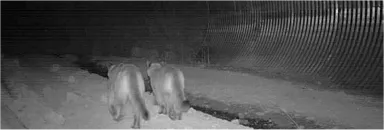Mitigating Wildlife Collisions:
Protecting Lives on the Road
Are you concerned about encounters with wild animals like lions, tigers, and bears, or even the deadliest threat on U.S. roads? Read on for a surprising insight.
Picture this: driving north on I-680 near Walnut Creek, nearing dusk after a long journey. Just minutes from home, a terrifying encounter unfolds. A large mule deer leaps into our path, a collision imminent. Miraculously, we avoid injury, but the aftermath is a sobering mess of fur, blood, and damaged vehicle.
Believe it or not, the deadliest wild animal on American roads isn’t a predator from the wild, but rather the unassuming deer. Shockingly, there were more than 1.8 million insurance claims to State Farm between June 2022 and July 2023, related to vehicle collisions with animals, resulting in hundreds of fatalities, thousands of injuries, and billions in property damage. Astonishingly, deer are responsible for a staggering majority of these incidents. State Farm reported over 1.2 million insurance claims involving deer from 2022-2023. California alone witnesses thousands of mule deer fatalities each year due to collisions.
Thankfully, there are solutions to mitigating these tragedies. Installing fencing along high-risk areas and implementing wildlife crossings like bridges and tunnels can help. Additionally, managing deer populations is crucial. The decline of natural predators has led to deer overpopulation, particularly in regions like the eastern U.S. where apex predators were eradicated in the past century.
Efforts to control deer, such as culls and sterilization, have had limited success. However, restoring large carnivores like mountain lions (also known as pumas or cougars) could offer a promising solution. Studies suggest that reintroducing pumas to suitable habitats in the eastern U.S. could significantly reduce deer populations and prevent thousands of human injuries and fatalities, as well as billions in economic costs.

Excitingly, recent research indicates that pumas are already expanding their range, offering hope for natural control of deer populations. By utilizing science-backed strategies, we could accelerate this process, benefitting both ecosystems and communities. Similar efforts could be employed in areas like the San Francisco Bay Area to reduce the risk of wildlife collisions and ensure safer roads for all.
Colliding with a deer at highway speeds is undeniably terrifying. But with proactive measures and innovative solutions, we can work towards a future where such encounters are minimized, safeguarding both human lives and wildlife.
References
Elbroch, M. 2023. Cougars Are Heading East. We Should Welcome Them. NY Times. https://www.nytimes.com/2023/01/12/opinion/cougars-migrating-east.html
Gilbert, S., K.J. Sivy, C.B. Pozzanghera, A. Du Bour, K. Overduijn, M.M. Smith, J. Zhou, J.M. Little & L.R. Prugh. 2017. Socioeconomic Benefits of Large Carnivore Recolonization Through Reduced Wildlife-Vehicle Collisions. Conservation Letters 10: 431-439.
Skroch, M. & T. Hilaire. 2021. Wildlife-Vehicle Collisions Are a Big and Costly Problem and Congress Can Help. Pew Trusts. https://www.pewtrusts.org/en/research-and-analysis/articles/2021/05/10/wildlife-vehicle-collisions-are-a-big-and-costly-problem-and-congress-can-help
State Farm Mutual Automobile Insurance Company. 25 Sept 2023. How likely are you to have a collision with an animal? https://www.statefarm.com/simple-insights/auto-and-vehicles/how-likely-are-you-to-have-an-animal-collision
Do You Have 2-4 Hours A Month To Preserve Your Local Ecosystem?
Our volunteers are the driving force behind making true change in ecosystem health and wild cat conservation. Some like to volunteer in the field, others help us maintain our online presence, and some work with events. With just a few hours a month, you can make a difference, too.
Make A Difference Right Now
As a 501(c)3 nonprofit, our work is only possible because of generous donors like you.
More than 90% of your donation will go directly to our groundbreaking research, outreach, and education programs.
This is where true change starts. If you’d like to be a part of it, make a donation to Felidae Conservation Fund today:
Or,
